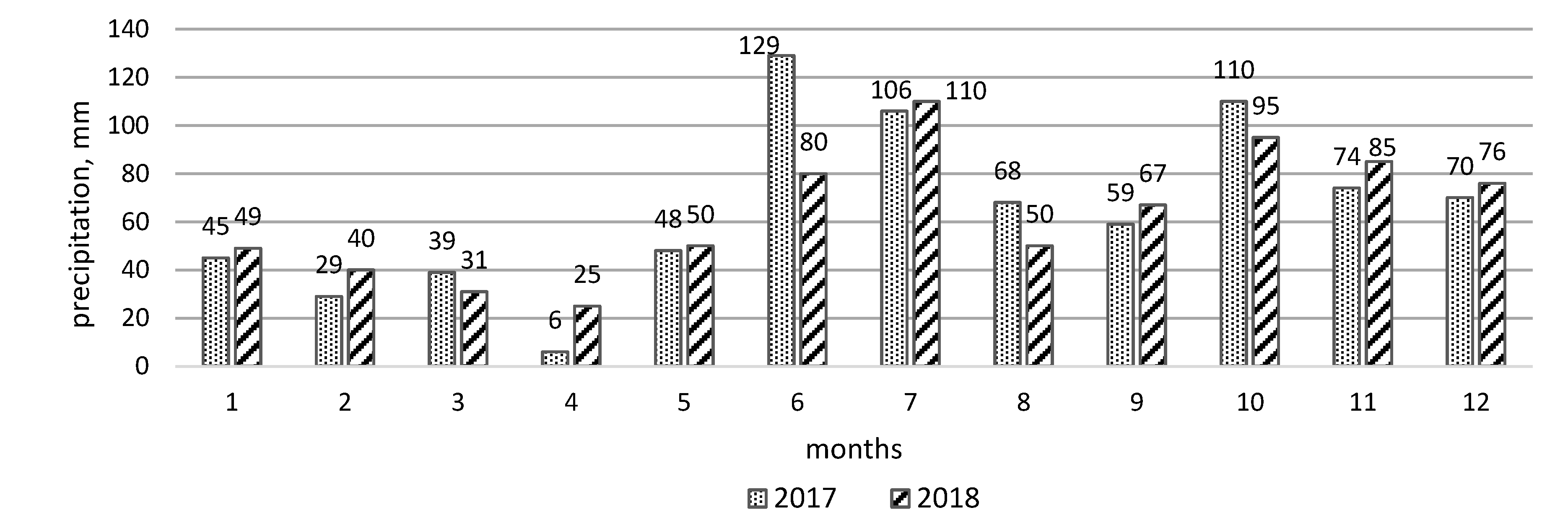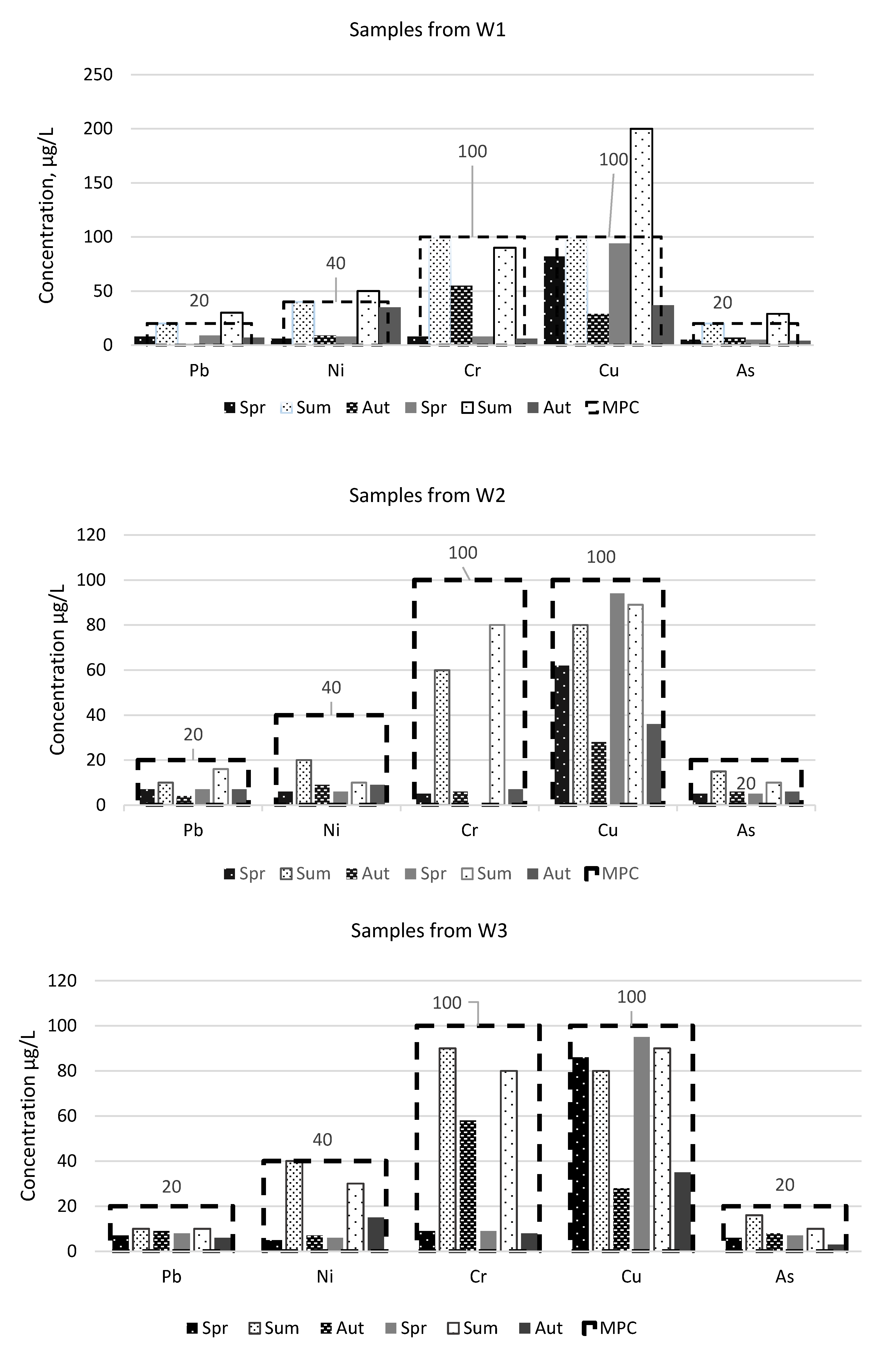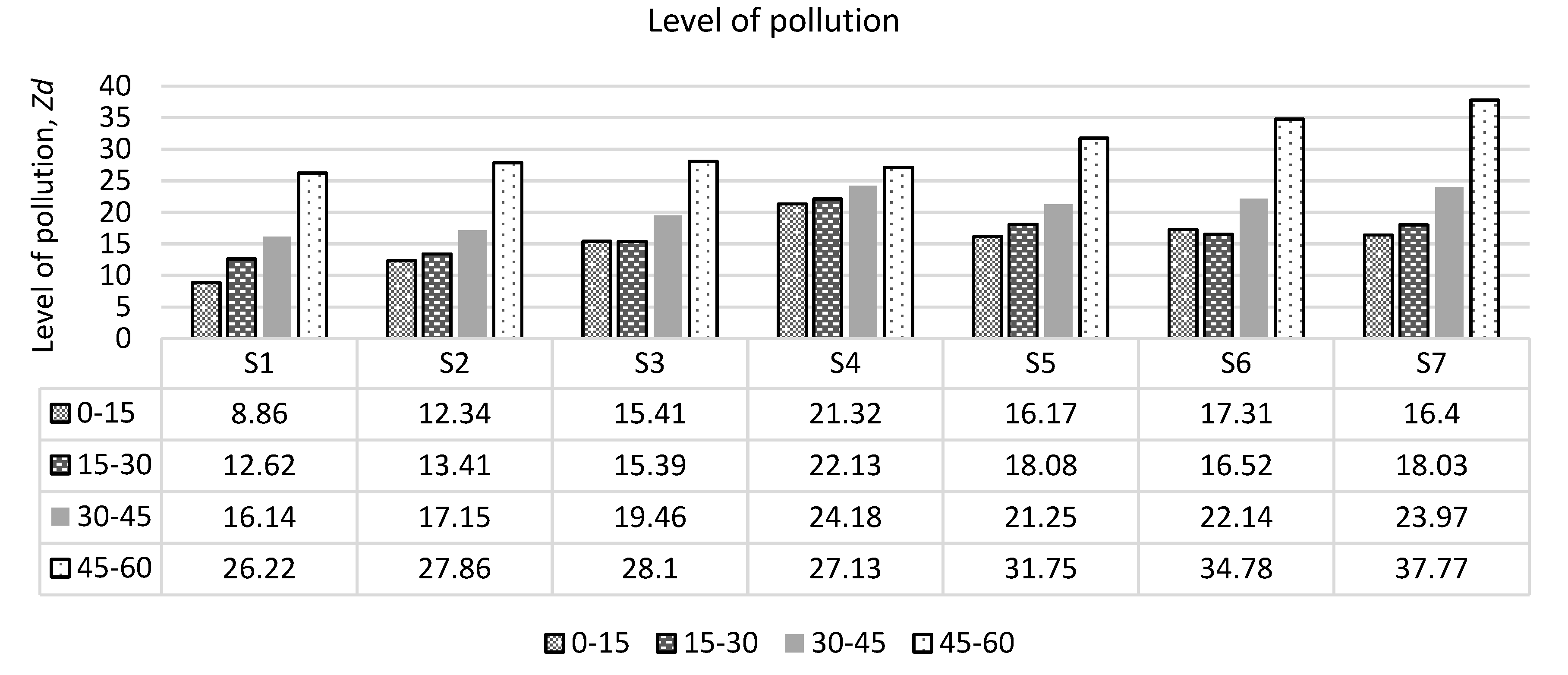Level of Pollution on Surrounding Environment from Landfill Aftercare
Abstract
:1. Introduction
2. Materials and Methods
3. Results and Discussion
3.1. Water Pollution
3.2. Soil and Sediments Pollution
4. Conclusions
Author Contributions
Funding
Conflicts of Interest
References
- Krausmann, F.; Gingrich, S.; Eisenmenger, N.; Erb, K.; Haberl, H.; Fischer-Kowalski, M. Growth in global materials use, GDP and population during the 20th century. Ecol. Econ. 2009, 68, 2696–2705. [Google Scholar] [CrossRef]
- European Parliament Council. A Community Strategy for Waste Management; SEC/89/934 (Final); European Parliament Council: Brussels, Belgium, 1989.
- European Parliament. Council of the European Union. Council Directive 1999/31/EC of 26 April 1999 on the landfill of waste. Off. J. Eur. Communities 1999, 182, 1–19. [Google Scholar]
- European Parliament. Appendix XVII REACH. no. 552/2009. Eur. Union Off. J. 2009, 164, 7–31. [Google Scholar]
- European Parliament. Council of the European Union. Proposal for a Directive of the European Parliament and of the Council Amending Directive 1999/31/EC on the Landfill of Waste 2015; European Parliament. Council of the European Union: Brussels, Belgium, 2015.
- Öman, C.; Junestedt, C. Chemical characterization of landfill leachates – 400 parameters and compounds. Waste Manag. 2008, 28, 1876–1891. [Google Scholar] [CrossRef] [PubMed]
- El-Fadel, M.; Bou-Zeid, E.; Chahine, W.; Alayli, B. Temporal variation of leachate quality from pre-sorted and baled municipal solid waste with high organic and moisture content. Waste Manag. 2002, 22, 269–282. [Google Scholar] [CrossRef]
- Ghosh, P.; Thakur, I.S.; Kaushik, A. Bioassays for toxicological risk assessment of landfill leachate: A review. Ecotoxicol. Env. Saf. 2017, 141, 259–270. [Google Scholar] [CrossRef]
- Tlotleng, N.; Kootbodien, T.; Wilson, K.; Made, F.; Mathee, A.; Ntlebi, V.; Kgalamono, S.; Mokone, M.; Du Preez, K.; Naicker, N. Prevalence of Respiratory Health Symptoms among Landfill Waste Recyclers in the City of Johannesburg, South Africa. Int. J. Environ. Res. Public Health 2019, 16, 4277. [Google Scholar] [CrossRef] [Green Version]
- Yan, X.; Liu, M.; Zhong, J.; Guo, J.; Wu, W. How Human Activities Affect Heavy Metal Contamination of Soil and Sediment in a Long-Term Reclaimed Area of the Liaohe River Delta, North China. Sustainability 2018, 10, 338. [Google Scholar] [CrossRef] [Green Version]
- Viard, B.; Pihan, F.; Promeyrat, S.; Pihan, J.-C. Integrated assessment of heavy metal (Pb, Zn, Cd) highway pollution: bioaccumulation in soil, Graminaceae and land snails. Chemosphere 2004, 55, 1349–1359. [Google Scholar] [CrossRef]
- Herva, M.; Roca, E. Ranking municipal solid waste treatment alternatives based on ecological footprint and multi-criteria analysis. Ecol. Indic. 2013, 25, 77–84. [Google Scholar] [CrossRef]
- Nazir, R.; Khan, M.; Masab, M.; Rehman, H.U.; Rauf, N.U.; Shahab, S.; Shaheen, Z. Accumulation of heavy metals (Ni, Cu, Cd, Cr, Pb, Zn, Fe) in the soil, water and plants and analysis of physico-chemical parameters of soil and water collected from Tanda Dam Kohat. J. Pharm. Health Serv. Res. 2015, 7, 89–97. [Google Scholar]
- Khallaf, E.; Authman, M.M.; Alne-Na-Ei, A.A. Contamination and Ecological Hazard Assessment of Heavy Metals in Freshwater Sediments and Oreochromis niloticus (Linnaeus, 1758) Fish Muscles in a Nile River Canal in Egypt. Env. Sci. Pollut. Res. 2018, 25, 13796–13812. [Google Scholar] [CrossRef]
- Li, F.; Cai, Y.; Zhang, J. Spatial Characteristics, Health Risk Assessment and Sustainable Management of Heavy Metals and Metalloids in Soils from Central China. Sustainability 2018, 10, 91. [Google Scholar] [CrossRef] [Green Version]
- Kumpiene, J.; Brännvall, E.; Taraškevičius, R.; Aksamitauskas, Č.; Zinkutė, R. Spatial variability of topsoil contamination with trace elements in preschools in Vilnius, Lithuania. J. Geochem. Explor. 2011, 108, 15–20. [Google Scholar] [CrossRef]
- Widomski, M.; Stępniewski, W.; Musz-Pomorska, A. Clays of Different Plasticity as Materials for Landfill Liners in Rural Systems of Sustainable Waste Management. Sustainability 2018, 10, 2489. [Google Scholar] [CrossRef] [Green Version]
- Zhou, M.-H.; Shen, S.-L.; Xu, Y.-S.; Zhou, A. New Policy and Implementation of Municipal Solid Waste Classification in Shanghai, China. Int. J. Environ. Res. Public Health 2019, 16, 3099. [Google Scholar] [CrossRef] [Green Version]
- Long, Y.; Shen, D.-S.; Wang, H.; Lu, W.; Zhao, Y. Heavy metal source analysis in municipal solid waste (MSW): Case study on Cu and Zn. J. Hazard. Mater. 2011, 186, 1082–1087. [Google Scholar] [CrossRef] [PubMed]
- Kanmani, S.; Gandhimathi, R. Assessment of heavy metal contamination in soil due to leachate migration from an open dumping site. Appl. Water Sci. 2012, 3, 193–205. [Google Scholar] [CrossRef] [Green Version]
- Van Ryan Kristopher, R.G.; Parilla, R. Analysis of heavy metals in Cebu city sanitary landfill, Philippines. J. Environ. Sci. Manag. 2014, 17, 50–59. [Google Scholar]
- Asgele, T.; Gebremedhin, K. Heavy metals analysis in solid municipal wastes. Int. J. Technol. Enhanc. Emerg. Eng. Res. 2015, 3, 7–10. [Google Scholar]
- Gworek, B.; Dmuchowski, W.; Koda, E.; Marecka, M.; Baczewska, A.H.; Brągoszewska, P.; Podlasek, A.; Osiński, P. Impact of the Municipal Solid Waste Łubna Landfill on Environmental Pollution by Heavy Metals. Water 2016, 8, 470. [Google Scholar] [CrossRef] [Green Version]
- Salminen, R.; Gregorauskien, V. Considerations regarding the definition of a geochemical baseline of elements in the surficial materials in areas differing in basic geology. Appl. Geochem. 2000, 15, 647–653. [Google Scholar] [CrossRef]
- Margui, E.; Queralt, I.; Hidalgo, M. Application of X-ray fluorescence spectrometry to determination and quantitation of metals in vegetal material. Trac Trends Anal. Chem. 2009, 28, 362–372. [Google Scholar] [CrossRef]
- Krishna, A.K.; Govil, P.K. Assessment of heavy metal contamination in soils around Manali industrial area, Chennai, Southern India. Environ. Earth Sci. 2007, 54, 1465–1472. [Google Scholar] [CrossRef]
- Bradl, H. Heavy Metals in the Environment: Origin, Interaction and Remediation; Academic: London, UK, 2002; p. 282. [Google Scholar]
- Kirpichtchikova, T.A.; Manceau, A.; Spadini, L.; Panfili, F.; Marcus, M.A.; Jacquet, T. Speciation and solubility of heavy metals in contaminated soil using X-ray microfluorescence, EXAFS spectroscopy, chemical extraction, and thermodynamic modeling. Geochim. Et Cosmochim. Acta 2006, 70, 2163–2190. [Google Scholar] [CrossRef]
- Voegelin, A.; Kretzschmar, R. Formation and Dissolution of Single and Mixed Zn and Ni Precipitates in Soil: Evidence from Column Experiments and Extended X-ray Absorption Fine Structure Spectroscopy. Environ. Sci. Technol. 2005, 39, 5311–5318. [Google Scholar] [CrossRef]
- O’Day, P.A.; Newville, M.; Neuhoff, P.S.; Sahai, N.; Carroll, S. X-Ray Absorption Spectroscopy of Strontium(II) Coordination. J. Colloid Interface Sci. 2000, 222, 184–197. [Google Scholar] [CrossRef]
- Sarret, G.; Balesdent, J.; Bouziri, L.; Garnier, J.-M.; Marcus, M.A.; Geoffroy, N.; Panfili, F.; Manceau, A. Zn Speciation in the Organic Horizon of a Contaminated Soil by Micro-X-ray Fluorescence, Micro- and Powder-EXAFS Spectroscopy, and Isotopic Dilution. Envron. Sci. Technol. 2004, 38, 2792–2801. [Google Scholar] [CrossRef] [Green Version]
- Manceau, A.; Marcus, M.A.; Tamura, N.; Proux, O.; Geoffroy, N.; Lanson, B. Natural speciation of Zn at the micrometer in a clayey soil using X-ray fluorescence, adsorption, and diffraction. Geochim. Et Cosmochim. Acta 2004, 68, 2467–2483. [Google Scholar] [CrossRef]
- Manceau, A.; Tommaseo, C.; Rihs, S.; Geoffroy, N.; Chateigner, D.; Schlegel, M.; Tisserand, D.; Marcus, M.A.; Tamura, N.; Chen, Z.-S. Natural speciation of Mn, Ni, and Zn at the micrometer scale in a clayey paddy soil using X-ray fluorescence, absorption, and diffraction. Geochim. Et Cosmochim. Acta 2005, 69, 4007–4034. [Google Scholar] [CrossRef] [Green Version]
- Vodyanitskii, Y.N. Standards for the contents of heavy metals in soils of some states. Ann. Agrar. Sci. 2016, 14, 257–263. [Google Scholar] [CrossRef] [Green Version]
- Lithuanian hygienic norm HN 60:2004 Maximum permitted concentrations of hazardous substances in soil (in Lithuanian). Valstyb. Žinios 2004, 41–1357.
- Rodic, L.; Wilson, D.C. Resolving governance issues to achieve priority SDGs related to solid waste management. Sustainability 2017, 9, 404. [Google Scholar] [CrossRef] [Green Version]
- Rimkus, E.; Kažys, J.; Bukantis, A. Predictions of heavy precipitation in the 21st century in Lithuania, based on the CCLM model. Geografija 2009, 45, 122–130. [Google Scholar]
- Lietuvos hidrometeorologinės tarnybos prie Aplinkos ministerijos skyriaus 2017 metų ataskaita. In 2017 Report of Lithuania Hydrometeorological Service by Ministry of Environment; Meteorological observations tables of Vilnius city station; LHMT: Vilnius, Lithuani, 2018; pp. 15–16.
- Lietuvos hidrometeorologinės tarnybos prie Aplinkos ministerijos skyriaus 2018 metų ataskaita. In 2018 Report of Lithuania Hydrometeorological Service by Ministry of Environment; Meteorological observations tables of Vilnius city station; LHMT: Vilnius, Lithuani, 2019; pp. 9–11.
- Wang, J.; Cheng, Q.; Xue, S.; Rajendran, M.; Wu, C.; Liao, J. Pollution characteristics of surface runoff under different restoration types in manganese tailing wasteland. Environ. Sci. Pollut. Res. 2018, 25, 9998–10005. [Google Scholar] [CrossRef] [PubMed]
- Sriuttha, M.; Tengjaroenkul, B.; Intamat, S.; Phoonaploy, U.; Thanomsangad, P.; Neeratanaphan, L. Cadmium, chromium, and lead accumulation in aquatic plants and animals near a municipal landfill. Hum. Ecol. Risk Assess. Int. J. 2017, 23, 350–363. [Google Scholar] [CrossRef]
- Abu-Daabes, M.A.; Abu Qdais, H.; Alsyouri, H. Assessment of Heavy Metals and Organics in Municipal Solid Waste Leachates from Landfills with Different Ages in Jordan. J. Environ. Prot. 2013, 4, 344–352. [Google Scholar] [CrossRef] [Green Version]








| Soil Contamination Category | Zd |
| Safe | Zd < 1 |
| Average hazard | 1 < Zd < 3 |
| Hazard | 3 < Zd < 10 |
| Very hazard | Zd > 10 |
| 2017 | 2018 | d | |||||||||
|---|---|---|---|---|---|---|---|---|---|---|---|
| Soil Samples | Unit, Part of MLC | As | Cr | Cu | Pb | Ni | As | Cr | Cu | Pb | Ni |
| Samples from 0–15 cm deep | |||||||||||
| S1 | % | 20 | 38 | 26 | 20 | 16 | 25 | 38 | 37 | 28 | 24 |
| S2 | % | 24 | 38 | 24 | 88 | 15 | 26 | 40 | 46 | 36 | 21 |
| S3 | % | 31 | 42 | 46 | 92 | 27 | 29 | 45 | 37 | 37 | 37 |
| S4 | % | 48 | 60 | 59 | 89 | 43 | 39 | 55 | 59 | 41 | 25 |
| S5 | % | 39 | 55 | 41 | 48 | 28 | 39 | 45 | 44 | 26 | 28 |
| S6 | % | 25 | 48 | 80 | 87 | 21 | 35 | 58 | 56 | 37 | 23 |
| S7 | % | 32 | 58 | 67 | 59 | 27 | 38 | 56 | 39 | 23 | 29 |
| Samples from 15–30 cm deep | |||||||||||
| S1 | % | 20 | 39 | 38 | 28 | 32 | 33 | 56 | 48 | 36 | 37 |
| S2 | % | 29 | 38 | 32 | 40 | 45 | 25 | 46 | 49 | 45 | 35 |
| S3 | % | 28 | 44 | 44 | 58 | 43 | 32 | 67 | 46 | 37 | 40 |
| S4 | % | 56 | 60 | 47 | 65 | 57 | 42 | 67 | 52 | 45 | 34 |
| S5 | % | 46 | 46 | 39 | 45 | 38 | 41 | 69 | 43 | 38 | 28 |
| S6 | % | 37 | 48 | 50 | 67 | 47 | 37 | 59 | 55 | 49 | 38 |
| S7 | % | 35 | 56 | 59 | 67 | 60 | 32 | 67 | 58 | 33 | 27 |
| Samples from 30–45 cm deep | |||||||||||
| S1 | % | 30 | 35 | 55 | 40 | 16 | 35 | 56 | 68 | 47 | 32 |
| S2 | % | 32 | 55 | 42 | 76 | 32 | 36 | 67 | 43 | 53 | 36 |
| S3 | % | 46 | 56 | 64 | 77 | 27 | 31 | 62 | 49 | 47 | 40 |
| S4 | % | 56 | 63 | 79 | 67 | 31 | 47 | 60 | 58 | 57 | 31 |
| S5 | % | 52 | 54 | 56 | 46 | 45 | 39 | 69 | 64 | 48 | 36 |
| S6 | % | 45 | 67 | 87 | 78 | 32 | 35 | 68 | 73 | 38 | 42 |
| S7 | % | 52 | 67 | 69 | 57 | 60 | 46 | 59 | 69 | 52 | 35 |
| Samples from 45–60 cm deep | |||||||||||
| S1 | % | 64 | 45 | 59 | 40 | 89 | 45 | 69 | 79 | 68 | 36 |
| S2 | % | 44 | 83 | 48 | 88 | 87 | 55 | 65 | 86 | 87 | 61 |
| S3 | % | 54 | 42 | 78 | 92 | 65 | 47 | 59 | 98 | 67 | 51 |
| S4 | % | 48 | 82 | 67 | 98 | 92 | 48 | 69 | 68 | 59 | 64 |
| S5 | % | 64 | 79 | 98 | 78 | 97 | 49 | 70 | 83 | 68 | 76 |
| S6 | % | 79 | 88 | 77 | 98 | 92 | 54 | 69 | 87 | 87 | 66 |
| S7 | % | 97 | 89 | 87 | 78 | 77 | 65 | 71 | 78 | 68 | 83 |
© 2020 by the authors. Licensee MDPI, Basel, Switzerland. This article is an open access article distributed under the terms and conditions of the Creative Commons Attribution (CC BY) license (http://creativecommons.org/licenses/by/4.0/).
Share and Cite
Baziene, K.; Tetsman, I.; Albrektiene, R. Level of Pollution on Surrounding Environment from Landfill Aftercare. Int. J. Environ. Res. Public Health 2020, 17, 2007. https://0-doi-org.brum.beds.ac.uk/10.3390/ijerph17062007
Baziene K, Tetsman I, Albrektiene R. Level of Pollution on Surrounding Environment from Landfill Aftercare. International Journal of Environmental Research and Public Health. 2020; 17(6):2007. https://0-doi-org.brum.beds.ac.uk/10.3390/ijerph17062007
Chicago/Turabian StyleBaziene, Kristina, Ina Tetsman, and Ramune Albrektiene. 2020. "Level of Pollution on Surrounding Environment from Landfill Aftercare" International Journal of Environmental Research and Public Health 17, no. 6: 2007. https://0-doi-org.brum.beds.ac.uk/10.3390/ijerph17062007




